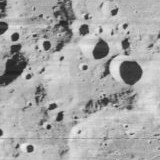 Oblique
Lunar Orbiter 4 image | |
| Coordinates | 51°06′N 86°18′W / 51.1°N 86.3°W |
|---|---|
| Diameter | 59 km |
| Depth | Unknown |
| Colongitude | 87° at sunrise |
| Eponym | Samuel P. Langley |
Langley is a lunar impact crater that is located close to the northwestern limb of the Moon, and from the Earth is viewed edge-on. It is located in the gap between the crater Galvani, which lies across the southeastern rim, and Volta along the northeastern rim. Just to the northwest is Stokes.
The rim of Langley has been heavily damaged by nearby impacts, and the result is an irregular perimeter that has been reshaped and heavily eroded. Galvani intrudes into the southeastern part of the floor, having overlaid that section of the rim. To the northeast is a pair of craters designated Langley J and Langley K. These lie proximal to each other, along the inner side of the rim shared with Volta. The western arc of the rim is the most intact section, although several small craters lie across the rim and along the sides. The interior floor of Langley is relatively featureless, with only a few craterlets.
Satellite craters
By convention these features are identified on lunar maps by placing the letter on the side of the crater midpoint that is closest to Langley.
| Langley | Latitude | Longitude | Diameter |
|---|---|---|---|
| J | 51.7° N | 85.2° W | 20 km |
| K | 52.0° N | 86.3° W | 20 km |
References
- Andersson, L. E.; Whitaker, E. A. (1982). NASA Catalogue of Lunar Nomenclature. NASA RP-1097.
- Blue, Jennifer (July 25, 2007). "Gazetteer of Planetary Nomenclature". USGS. Retrieved 2007-08-05.
- Bussey, B.; Spudis, P. (2004). The Clementine Atlas of the Moon. New York: Cambridge University Press. ISBN 978-0-521-81528-4.
- Cocks, Elijah E.; Cocks, Josiah C. (1995). Who's Who on the Moon: A Biographical Dictionary of Lunar Nomenclature. Tudor Publishers. ISBN 978-0-936389-27-1.
- McDowell, Jonathan (July 15, 2007). "Lunar Nomenclature". Jonathan's Space Report. Retrieved 2007-10-24.
- Menzel, D. H.; Minnaert, M.; Levin, B.; Dollfus, A.; Bell, B. (1971). "Report on Lunar Nomenclature by the Working Group of Commission 17 of the IAU". Space Science Reviews. 12 (2): 136–186. Bibcode: 1971SSRv...12..136M. doi: 10.1007/BF00171763. S2CID 122125855.
- Moore, Patrick (2001). On the Moon. Sterling Publishing Co. ISBN 978-0-304-35469-6.
- Price, Fred W. (1988). The Moon Observer's Handbook. Cambridge University Press. ISBN 978-0-521-33500-3.
- Rükl, Antonín (1990). Atlas of the Moon. Kalmbach Books. ISBN 978-0-913135-17-4.
- Webb, Rev. T. W. (1962). Celestial Objects for Common Telescopes (6th revised ed.). Dover. ISBN 978-0-486-20917-3.
- Whitaker, Ewen A. (1999). Mapping and Naming the Moon. Cambridge University Press. ISBN 978-0-521-62248-6.
- Wlasuk, Peter T. (2000). Observing the Moon. Springer. ISBN 978-1-85233-193-1.
 Oblique
Lunar Orbiter 4 image | |
| Coordinates | 51°06′N 86°18′W / 51.1°N 86.3°W |
|---|---|
| Diameter | 59 km |
| Depth | Unknown |
| Colongitude | 87° at sunrise |
| Eponym | Samuel P. Langley |
Langley is a lunar impact crater that is located close to the northwestern limb of the Moon, and from the Earth is viewed edge-on. It is located in the gap between the crater Galvani, which lies across the southeastern rim, and Volta along the northeastern rim. Just to the northwest is Stokes.
The rim of Langley has been heavily damaged by nearby impacts, and the result is an irregular perimeter that has been reshaped and heavily eroded. Galvani intrudes into the southeastern part of the floor, having overlaid that section of the rim. To the northeast is a pair of craters designated Langley J and Langley K. These lie proximal to each other, along the inner side of the rim shared with Volta. The western arc of the rim is the most intact section, although several small craters lie across the rim and along the sides. The interior floor of Langley is relatively featureless, with only a few craterlets.
Satellite craters
By convention these features are identified on lunar maps by placing the letter on the side of the crater midpoint that is closest to Langley.
| Langley | Latitude | Longitude | Diameter |
|---|---|---|---|
| J | 51.7° N | 85.2° W | 20 km |
| K | 52.0° N | 86.3° W | 20 km |
References
- Andersson, L. E.; Whitaker, E. A. (1982). NASA Catalogue of Lunar Nomenclature. NASA RP-1097.
- Blue, Jennifer (July 25, 2007). "Gazetteer of Planetary Nomenclature". USGS. Retrieved 2007-08-05.
- Bussey, B.; Spudis, P. (2004). The Clementine Atlas of the Moon. New York: Cambridge University Press. ISBN 978-0-521-81528-4.
- Cocks, Elijah E.; Cocks, Josiah C. (1995). Who's Who on the Moon: A Biographical Dictionary of Lunar Nomenclature. Tudor Publishers. ISBN 978-0-936389-27-1.
- McDowell, Jonathan (July 15, 2007). "Lunar Nomenclature". Jonathan's Space Report. Retrieved 2007-10-24.
- Menzel, D. H.; Minnaert, M.; Levin, B.; Dollfus, A.; Bell, B. (1971). "Report on Lunar Nomenclature by the Working Group of Commission 17 of the IAU". Space Science Reviews. 12 (2): 136–186. Bibcode: 1971SSRv...12..136M. doi: 10.1007/BF00171763. S2CID 122125855.
- Moore, Patrick (2001). On the Moon. Sterling Publishing Co. ISBN 978-0-304-35469-6.
- Price, Fred W. (1988). The Moon Observer's Handbook. Cambridge University Press. ISBN 978-0-521-33500-3.
- Rükl, Antonín (1990). Atlas of the Moon. Kalmbach Books. ISBN 978-0-913135-17-4.
- Webb, Rev. T. W. (1962). Celestial Objects for Common Telescopes (6th revised ed.). Dover. ISBN 978-0-486-20917-3.
- Whitaker, Ewen A. (1999). Mapping and Naming the Moon. Cambridge University Press. ISBN 978-0-521-62248-6.
- Wlasuk, Peter T. (2000). Observing the Moon. Springer. ISBN 978-1-85233-193-1.